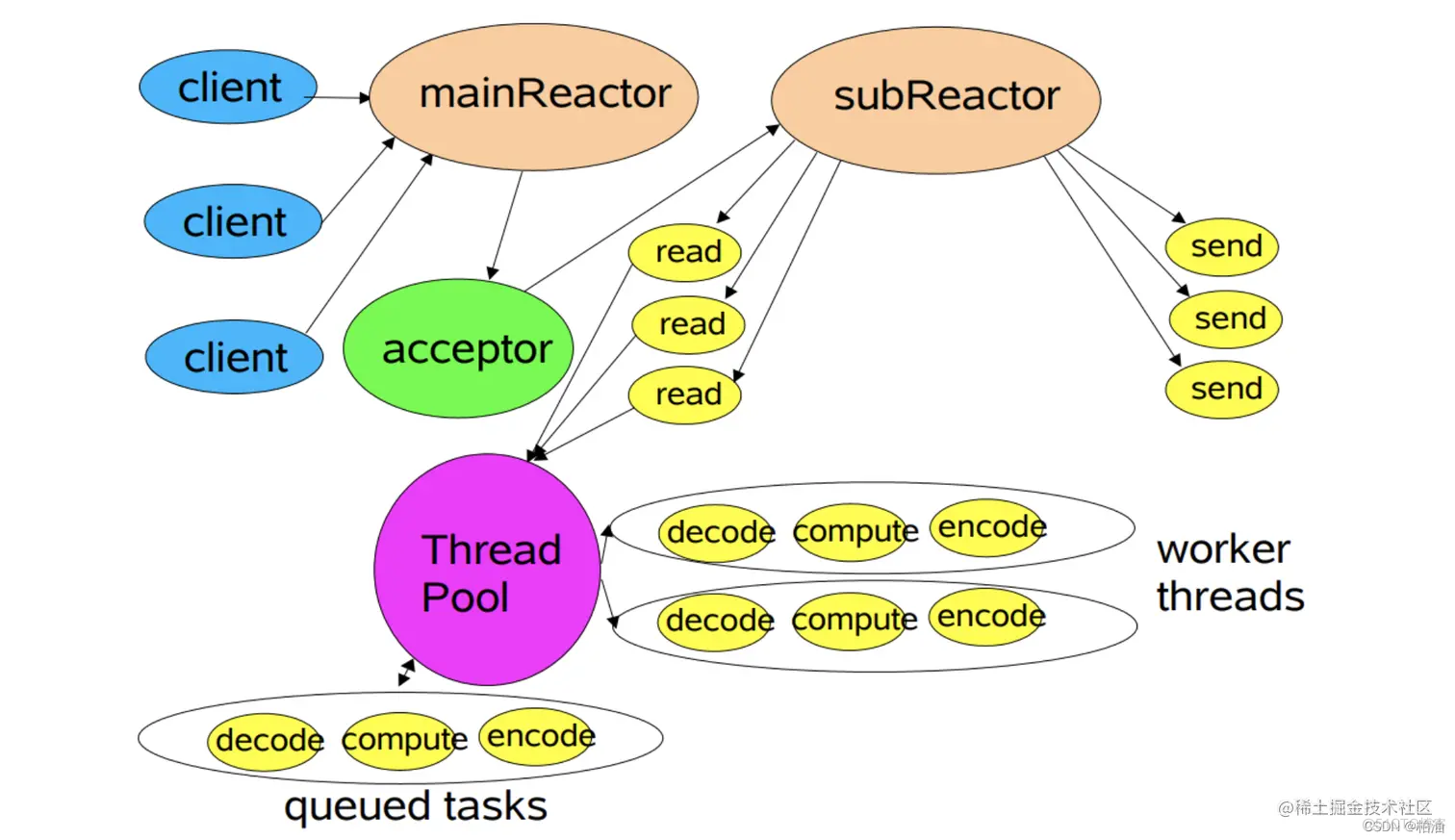1. 背景
在Hadoop的性能指标中,rpc是最核心的一类指标,它标志着Hadoop服务的性能。通过该指标能够判断服务此时是否正常。如下所示:

同时,在配置文件中,还有很多rpc相关的重要配置,例如:
- ipc.server.handler.queue.size
- ipc.server.read.threadpool.size
- dfs.namenode.handler.count
作为Hadoop开发运维人员,一定要对Hadoop RPC有深入的了解,否则根本不懂上面的配置和指标具体含义,也无法对集群进行优化。
2. Reactor模型
在多路复用模型之前,如果只使用non Blocking IO,用户空间需要不断发起read系统调用等待linux内核数据复制到缓冲区完成,导致CPU资源不足。
为了解决该问题,各操作系统都提供了select和epoll系统调用。它们会监听socket连接请求、读请求、写请求。一旦socket网络连接有数据达到,api就会返回该网络链接,后续通过该连接处理数据即可。用户空间只需要一个线程,就可以维护成千上万的连接,就是多路复用。
对于Selector,如果读写处理逻辑非常耗时,会阻塞住整个服务线程,导致acceptor无法处理连接请求,因此可以将读写请求相关连接注册到新的Selector中。AcceptorSelector和SubSelector分别就是主从复用器。
基于Selector的socket处理模型就是Reactor模型。Reactor主从多路复用模型如下所示:

3. Hadoop Reactor RPC处理流程
对于Hadoop RPC来说,处理RPC请求的简要流程如下:
- Listener线程接受客户端请求。
- 由Reader线程池处理请求。
- 将请求封装成为Call对象放到BlockingQueue中。
- Handler线程池消费BlockingQueue,处理call请求。
- Responder线程返回处理结果。

上面是Hadoop RPC最基本的处理流程,它基于Reactor模型进行实现。在Listener线程中通过Selector接受连接,该Selector只吃力accept请求;在Reader线程中将连接注册到ReaderSelector中,该Selector只处理read请求;在Responder线程中将连接注册到WriterSelector中,该Selector只处理write请求。如下所示:

3.1 RPC Server启动线程
Server先创建固定的线程Responder、Listener和Handler:
/** Starts the service. Must be called before any calls will be handled. */
public synchronized void start() {
responder.start();
listener.start();
handlers = new Handler[handlerCount];
for (int i = 0; i < handlerCount; i++) {
handlers[i] = new Handler(i);
handlers[i].start();
}
}
Reader是Listener的内部类,在Listener的构造函数中可以看到:
readers = new Reader[readThreads];//readThreads个Reader进行处理
for (int i = 0; i < readThreads; i++) {
Reader reader = new Reader(
"Socket Reader #" + (i + 1) + " for port " + port);
readers[i] = reader;
reader.start();
}
3.2 Listener线程注册accept事件
Listener只处理accept事件:
public void run() {
LOG.info(Thread.currentThread().getName() + ": starting");
SERVER.set(Server.this);
connectionManager.startIdleScan();
while (running) {
SelectionKey key = null;
try {
getSelector().select();
Iterator<SelectionKey> iter = getSelector().selectedKeys().iterator();
while (iter.hasNext()) {
key = iter.next();
iter.remove();
try {
if (key.isValid()) {
if (key.isAcceptable()) //一个新的socket连接请求是否被接受
doAccept(key);//执行ACCEPT对应的处理逻辑
}
} catch (IOException e) {
//.....
}
key = null;
}
} catch (OutOfMemoryError e) {
//......
} catch (Exception e) {
closeCurrentConnection(key, e);
}
}
LOG.info("Stopping " + Thread.currentThread().getName());
//....
//关闭连接操作
}
}
注册后,将连接放到Reader对象所维护的一个连接队列pendingConnections ,待Reader线程处理:
/**
* 执行接受新的socket的连接请求的逻辑
*/
void doAccept(SelectionKey key) throws InterruptedException, IOException, OutOfMemoryError {
ServerSocketChannel server = (ServerSocketChannel) key.channel();
SocketChannel channel;
while ((channel = server.accept()) != null) {
//非关键代码 略
Reader reader = getReader(); //采用轮询方式在众多的reader中取出一个reader进行处理
Connection c = connectionManager.register(channel);
// If the connectionManager can't take it, close the connection.
if (c == null) {
if (channel.isOpen()) {
IOUtils.cleanup(null, channel);
}
continue;
}
//将这个封装了对应的SocketChannel的Connection对象attatch到当前这个SelectionKey对象上
//这样,如果这个SelectionKey对象对应的Channel有读写事件,就可以从这个SelectionKey上取出
//Connection,获取到这个Channel的相关信息
key.attach(c); // so closeCurrentConnection can get the object
//将当前的connection添加给reader的connection队列,reader将会依次从队列中取出连接进行处理
reader.addConnection(c);
}
}
3.3 Reader线程注册read事件
Reader线程将pendingConnections 中的连接注册到readSelector中:
private synchronized void doRunLoop() {
while (running) {
SelectionKey key = null;
try {
// consume as many connections as currently queued to avoid
// unbridled acceptance of connections that starves the select
int size = pendingConnections.size();
for (int i=size; i>0; i--) {
Connection conn = pendingConnections.take();
conn.channel.register(readSelector, SelectionKey.OP_READ, conn);//向Selector注册OP_READ
}
readSelector.select();
Iterator<SelectionKey> iter = readSelector.selectedKeys().iterator();
while (iter.hasNext()) {
key = iter.next();
iter.remove();
if (key.isValid()) {
if (key.isReadable()) {
doRead(key);
}
}
key = null;
}
} catch (InterruptedException e) {
//....
}
}
}
doRead方法最终会调用processRpcRequest,将请求封装成为Call对象放入到callQueue中:
private void processRpcRequest(RpcRequestHeaderProto header,
DataInputStream dis) throws WrappedRpcServerException,
InterruptedException {
//获取RPC类型,目前主要有两种RPC类型有WritableRPC 和ProtobufRPC
//老版本的Hadoop使用WritableRPC,新版本的Hadoop开始使用基于Protobuf协议的RPC,即ProtobufRPC
//以ProtobufRpcEngine为例,对应的WrapperClass是ProtobufRpcEngine.RpcRequestWrapper
//提取并实例化wrapper class,用来解析请求中的具体字段
Class<? extends Writable> rpcRequestClass =
getRpcRequestWrapper(header.getRpcKind());
if (rpcRequestClass == null) {
//无法从header中解析出对应的RPCRequestClass,抛出异常
}
Writable rpcRequest;
try { //Read the rpc request
//可以将rpcRequestClass理解为当前基于具体某个序列化协议的解释器,解释器负责解释
//和解析请求内容,封装为rpcRequest对象
rpcRequest = ReflectionUtils.newInstance(rpcRequestClass, conf);
rpcRequest.readFields(dis);
} catch (Throwable t) { // includes runtime exception from newInstance
//数据解析发生异常,则抛出异常
}
//略
//根据请求中提取的callId、重试次数、当前的连接、RPC类型、发起请求的客户端ID等,创建对应的Call对象
Call call = new Call(header.getCallId(), header.getRetryCount(),
rpcRequest, this, ProtoUtil.convert(header.getRpcKind()),
header.getClientId().toByteArray(), traceSpan);
//将Call对象放入callQueue中,Handler线程将负责从callQueue中逐一取出请求并处理
callQueue.put(call); // queue the call; maybe blocked here
incRpcCount(); // Increment the rpc count
}
Handler线程消费callQueue,调用call方法进行实际的rpc请求处理,最后通过responder.doRespond方法将Call对象添加到当前这个Connection的responseQueue 中:
public void run() {
SERVER.set(Server.this);
ByteArrayOutputStream buf =
new ByteArrayOutputStream(INITIAL_RESP_BUF_SIZE);
while (running) {
try {
//从callQueue中取出Call对象,Call对象封装了请求的所有信息,包括连接对象、序列号等等信息
final Call call = callQueue.take(); // pop the queue; maybe blocked here
//判断这个请求对应是SocketChannel是否是open状态,如果不是,可能客户端已经断开连接,没有响应的必要
if (!call.connection.channel.isOpen()) {
LOG.info(Thread.currentThread().getName() + ": skipped " + call);
continue;
}
//略
CurCall.set(call);
try {
//call方法是一个抽象方法,实际运行的时候会调用具体实现类的call
value = call(call.rpcKind, call.connection.protocolName,
call.rpcRequest, call.timestamp);
} catch (Throwable e) {
//发生异常,根据异常的类型,设置异常的详细信息、返回码等等
}
//服务端调用结束,即服务端已经完成了客户端请求的相关操作,开始对响应进行设置,将响应发送给客户端
CurCall.set(null);
synchronized (call.connection.responseQueue) {
//将error信息封装在call对象中,responder线程将会处理这个Call对象,向客户端返回响应
setupResponse(buf, call, returnStatus, detailedErr,
value, errorClass, error);
//将封装了Error信息或者成功调用的信息的Call对象交付给Responder线程进行处理
responder.doRespond(call);
}
} catch (InterruptedException e) {
//异常信息
} finally {
//略
}
LOG.debug(Thread.currentThread().getName() + ": exiting");
}
}
3.4 Responder线程注册write事件
Responder线程消费responseQueue,将连接注册到writeSelector,想客户端返回响应信息:
private boolean processResponse(LinkedList<Call> responseQueue,
boolean inHandler) throws IOException {
try {
synchronized (responseQueue) {
//先进先出,因此从respondeQueue中取出第一个Call对象进行处理
call = responseQueue.removeFirst();//
SocketChannel channel = call.connection.channel;
//将call.rpcResponse中的数据写入到channel中
int numBytes = channelWrite(channel, call.rpcResponse);
if (!call.rpcResponse.hasRemaining()) {//数据已经写入完毕
//数据已经写完,进行一个buffer的清理工作
} else {
//如果数据没有完成写操作,则把Call对象重新放进responseQueue中的第一个,下次会进行发送剩余数据
call.connection.responseQueue.addFirst(call);
//如果是inHandler,说明这个方法是Handler直接调用的,这时候数据没有发送完毕,需要将channel注册到writeSelector, 这样Responder.doRunLoop()中就可以检测到这个writeSelector上的writable的SocketChannel,然后把剩余数据发送给客户端
if (inHandler) {
// Wakeup the thread blocked on select, only then can the call
// to channel.register() complete.
writeSelector.wakeup();
//将channel注册到writeSelector,同时将这个Call对象attach到这个SelectionKey对象,这样Responder线程就可以通过select方法检测到channel上的写事件,同时从Call中提取需要写的数据以及SocketChannel,进而进行写操作
channel.register(writeSelector, SelectionKey.OP_WRITE, call);
}
}
error = false; // everything went off well
}
}
return done;
}
3.5 Rpc反射调用流程
在Handler中,会通过call执行rpc逻辑,对于ProtobufRpcEngine,它会通过反射进行执行:
/**
* This is a server side method, which is invoked over RPC. On success
* the return response has protobuf response payload. On failure, the
* exception name and the stack trace are return in the resposne.
* See {@link HadoopRpcResponseProto}
*
* In this method there three types of exceptions possible and they are
* returned in response as follows.
* <ol>
* <li> Exceptions encountered in this method that are returned
* as {@link RpcServerException} </li>
* <li> Exceptions thrown by the service is wrapped in ServiceException.
* In that this method returns in response the exception thrown by the
* service.</li>
* <li> Other exceptions thrown by the service. They are returned as
* it is.</li>
* </ol>
*/
public Writable call(RPC.Server server, String protocol,
Writable writableRequest, long receiveTime) throws Exception {
RpcRequestWrapper request = (RpcRequestWrapper) writableRequest;
RequestHeaderProto rpcRequest = request.requestHeader;
//从请求中获取方法、协议名称
String methodName = rpcRequest.getMethodName();
//从请求中取出proto名称
String protoName = rpcRequest.getDeclaringClassProtocolName();
//从请求中取出版本号
long clientVersion = rpcRequest.getClientProtocolVersion();
if (server.verbose)
LOG.info("Call: protocol=" + protocol + ", method=" + methodName);
//向RPC.Server()获取它所管理的具体协议对应的实现,比如ResourceTracker协议对应的BlockingService
ProtoClassProtoImpl protocolImpl = getProtocolImpl(server, protoName,
clientVersion);
//这个service是在ResourceTracker里面创建的一个匿名实例newReflectiveBlockingService()
BlockingService service = (BlockingService) protocolImpl.protocolImpl;
//通过远程调用的方法名称,获取方法描述信息
MethodDescriptor methodDescriptor = service.getDescriptorForType()
.findMethodByName(methodName);
if (methodDescriptor == null) {
//......throw exception
}
//获取请求的proto对应的java 类,如RegisterNodeManagerRequestProto,通过protobuf生成的proto的java类都是一个Message
Message prototype = service.getRequestPrototype(methodDescriptor);
//将实际请求的参数数据匹配到对应的请求类
Message param = prototype.newBuilderForType()
.mergeFrom(request.theRequestRead).build();
Message result;
long startTime = Time.now();
int qTime = (int) (startTime - receiveTime);
Exception exception = null;
try {
server.rpcDetailedMetrics.init(protocolImpl.protocolClass);
result = service.callBlockingMethod(methodDescriptor, null, param);
} catch (ServiceException e) {
//.....throw some exception....
} finally {
int processingTime = (int) (Time.now() - startTime);
if (LOG.isDebugEnabled()) {
String msg = "Served: " + methodName + " queueTime= " + qTime +
" procesingTime= " + processingTime;
if (exception != null) {
msg += " exception= " + exception.getClass().getSimpleName();
}
LOG.debug(msg);
}
String detailedMetricsName = (exception == null) ?
methodName :
exception.getClass().getSimpleName();
server.rpcMetrics.addRpcQueueTime(qTime);
server.rpcMetrics.addRpcProcessingTime(processingTime);
server.rpcDetailedMetrics.addProcessingTime(detailedMetricsName,
processingTime);
}
return new RpcResponseWrapper(result);
}
4. Hadoop RPC常用配置
ipc.server.listen.queue.size=4096:Hadoop Server的socket监听的backlog上限。当一个请求未被处理时,进入backlog,当server处理请求较慢时,监听队列被填满,新来的请求会被拒绝。
ipc.client.fallback-to-simple-auth-allowed=true:使用kerberos访问非kerberos集群,系统自动转成简单认证。
ipc.client.connection.maxidletime=20000:若在20s内没有请求则连接主动关闭。
ipc.server.read.threadpool.size=24:reader线程池大小。
ipc.maximum.data.length=201326592:客户端请求或者响应数据不能超过192MB。
ipc.server.handler.queue.size=100:每个handler能够处理的call队列长度为100。
dfs.namenode.handler.count=1024:namenode服务处理客户端请求的handler线程数。
dfs.namenode.service.handler.count=256:namenode处理内部请求的handler线程数,包含DataNode,JournalNode等。
callQueue长度:callQueue是BlockingQueue类型。它的上限为ipc.server.handler.queue.size * handler,即每个handler能够处理的call请求*handler线程数。对于namenode来说,其处理客户端请求的callQueue的上限是1024 * 256 = 262144。
5. 总结
Hadoop通过Reactor模型实现了RPC Server。在Listener线程中通过Selector接受连接,该Selector只吃力accept请求;在Reader线程中将连接注册到ReaderSelector中,该Selector只处理read请求;在Responder线程中将连接注册到WriterSelector中,该Selector只处理write请求。
它在Handler线程中执行具体的rpc逻辑,通过call方法,找到协议的实现类,通过反射的方法执行。



















